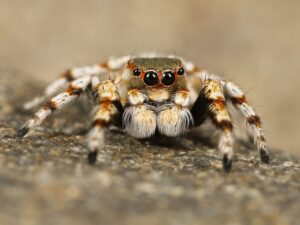 Greetings, readers. Today we learn about EEEEK spiders! as we continue our series, Caring for Mother Nature, by my friend, author and naturalist, Peggy Sias Lantz (click her name to visit her website).
Greetings, readers. Today we learn about EEEEK spiders! as we continue our series, Caring for Mother Nature, by my friend, author and naturalist, Peggy Sias Lantz (click her name to visit her website).
Spiders
by Peggy Lantz
Did your kindergartener or first grader ever come home from school singing this little song with finger motions? I taught it to a lot of children in Winter Garden many years ago when I served as music teacher.
Teensy weensy spider went up the water spout.
Down came the rain and washed the spider out.
Out came the sun and dried up all the rain,
And teensy weensy spider went up the spout again.
What are spiders?
It may surprise you, but spiders are not insects. They belong to a different group of animals called arachnids, which include ticks, scorpions, mites, and daddy longlegs.
So what’s the difference between an insect and a spider? The easiest way to tell is spiders have eight legs and insects have six. Spiders have two body parts – its head and thorax are fused together; insects have three. Spiders and insects both have exoskeletons. Spiders have eight eyes and have spinnerets to make their webs.
Florida has a lot of different species of spiders, about 900. Most of them are very teensy.
Where are spiders?
Some spiders live in holes in the ground. They’re called wolf spiders, and they capture their prey when one walks close by pouncing on them. Some spiders can jump several times their own length to capture prey. Some spiders live near streams and ponds and catch small fish. The front two pairs of legs of crab spiders are longer than the two back pairs.
And then there are the house spiders that do us the honor of ridding us of insects we like even less than spiders. Spitting spiders, wandering spiders, longlegged spiders – the list goes on of cute names for kinds of spiders.
Very few spiders cause any harm to humans, but widow spiders – black widow with a red hour glass mark on its underside, brown widow with an orange mark, and the colorful red widow – have potent venom that can cause considerable pain and symptoms.
The wonderful spider web
And here’s the fun part about spiders – the web weavers. Not all webs are the beautiful wagon-wheel orbs that hang from branches to capture prey that flies into them. Some build tangle webs in the grass or in trees, or sheet webs, or a web like a funnel.
All spiders have silk to wrap their eggs in, but not all use webs to capture prey. Those that do have several different kinds of silk. The silk isn’t sprayed out like Spiderman’s web, but is pulled out with the spider’s feet. They have a special silk to protect their eggs, and another special spinneret for the newly hatched babies to float away on the breeze away from the nest. And they have a non-sticky silk to make the frame of the web, and a sticky silk to catch flies or moths. And, yes, the spider has to avoid the sticky parts, too.
Watching a spider weave its web is fascinating. My Dad took me outside to watch a web weaver when I was very little, and I showed my children spiders weaving their webs.
Can spiders learn?
It would seem so. Spiders always began to build their webs across my horseback riding trails in August, and I would keep running into them until late November. But whenever they hung too low, I would take their webs down, trying to do it carefully so they could fasten it up again on the other side. The spiders ran, all shaken up. But very frequently I would find the next day that the web has been rebuilt, but higher up, sometimes high enough so I could duck under it.
Other times I’d have to tear it down again to get under it, and the next day it’d be up a little higher or even alongside the trail. These spiders were usually golden orb spiders, sometimes writing spiders. Others I often saw were the small spiny crab spiders. And once I saw a magnificently colorful spider.
Are you among the people who suffer from arachnophobia – fear of spiders? All I can say is, I’m sorry you can’t enjoy these beautiful and interesting animals.
Recommended reading on spiders
Florida’s Fabulous Spiders by E. G. Edwards
—END—
Thanks for reading!
Your writer on the wing,
Charlene






